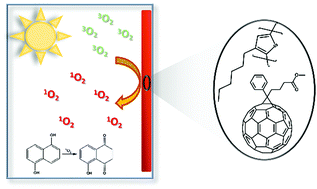Singlet oxygen formation from photoexcited P3HT:PCBM films applied in oxidation reactions†
Abstract
Poly(3-hexylthiophene) thin films containing carbon-based nanostructures, i.e. fullerenes such as buckminsterfullerene (C60) or phenyl-C61-butyric acid methyl ester (PCBM), or single-walled carbon nanotubes, were investigated as heterogeneous photosensitizers producing singlet oxygen (1O2) in aerated organic solvents. Thin films were deposited on borosilicate glass using spin coating and characterized by profilometry, UV-vis, Raman and XPS. Photogeneration of 1O2 was confirmed by photooxidation of 1,3-diphenylisobenzofuran and by reaction of 1,5-dihydroxynaphthalene to juglone. The photochemical efficiency of the blends was found to depend on the carbon-based photosensitizer and can be increased by varying its concentration in the poly(3-hexylthiophene) matrix.



 Please wait while we load your content...
Please wait while we load your content...